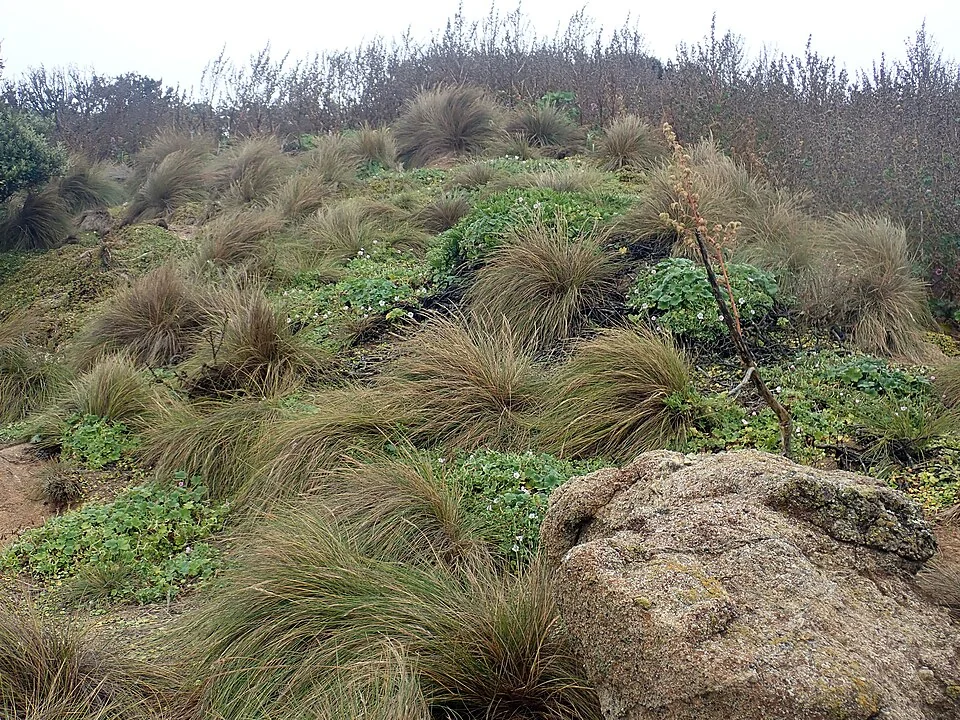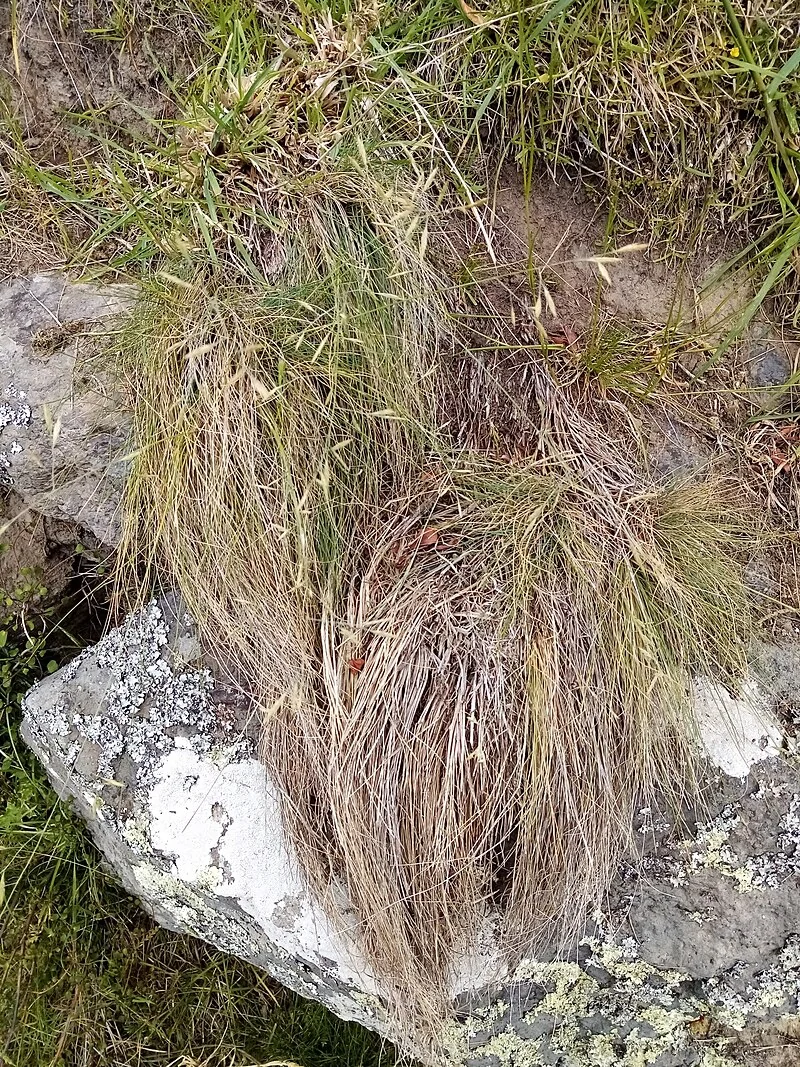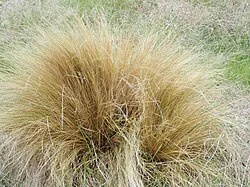
Cox's Fescue
Festuca coxii
Festuca coxii , also known as Cox's Fescue or Blue Fescue, is a hardy, native New Zealand ornamental grass. It forms a dense, tufted tussock with a clump-forming habit, typically growing up to 35 cm tall and 40 cm wide. The leaves are slender, arching, and range in colour from glaucous to dark green, blue-green, or light silvery blue. They are softly sharp-pointed, terete to somewhat compressed, and have numerous short prickle-teeth on the upper surface and margin. grasses .

Plant Description
Festuca coxii , known as Cox's Fescue, is a striking ornamental grass native to New Zealand's Chatham Islands. It forms a dense, neat tussock of fine, needle-like leaves that gracefully arch outwards. The foliage is a captivating silvery-blue, which can vary in intensity depending on the season and growing conditions. During the summer, it produces delicate, straw-coloured flower heads that rise above the foliage, adding to its ornamental appeal. This compact grass typically reaches a height and spread of 30-40 cm, making it an excellent choice for borders, rock gardens, or mass plantings.
Quick Facts
| Scientific Name | Festuca Coxii |
|---|---|
| Common Name | Cox's Fescue, Blue Fescue |
| Plant Type | Perennial grass |
| Height | Up to 35 cm |
| Spread | 20-40 cm |
| Foliage | Slender, arching, glaucous to dark green, blue-green, or light silvery blue |
| Inflorescence | Short, compact, nodding panicle with straw-coloured seed heads |
| Water Needs | Low; drought tolerant once established |
| Light | Full sun or light shade |
| Frost Tolerance | Hardy to -30°C |
| Salt Tolerance | Good |
| Growth Rate | Medium |
| Lifespan | Perennial, but can be short-lived. Divide every 2-3 years to maintain vigour. |
| Habitat | Coastal rock ledges, cliff faces, rock stacks, peaty turf, exposed ridge lines |
| Growing Conditions | Full sun or light shade, well-drained soil, tolerates strong winds, salt spray, dry conditions |
| Uses | Low-maintenance landscaping, erosion control, mass plantings, borders, rock gardens |
| Propagation | Seed or division |
Climate Best Suited to
Well adapted to cool, dry temperate to subalpine climates where summers are sunny and soils are low in nutrients. It tolerates frequent frosts and persistent wind, provided the site drains freely after rain. In humid or wet regions, plant on slopes, berms, or raised scree to keep crowns dry and foliage tight.
Regional Suitability
| City | Climate Suitability |
|---|---|
| Whangārei | Ideal |
| Auckland | Ideal |
| Hamilton | Ideal |
| Tauranga | Ideal |
| Rotorua | Ideal |
| Gisborne | Ideal |
| New Plymouth | Ideal |
| Napier | Ideal |
| Whanganui | Ideal |
| Palmerston North | Ideal |
| Wellington | Ideal |
| Nelson | Ideal |
| Christchurch | Ideal |
| Dunedin | Ideal |
| Invercargill | Ideal |
Natural Habitat
Festuca coxii is endemic to the Chatham Islands, where it grows in harsh coastal environments. It is commonly found on rock ledges, cliff faces, rock stacks, and in peaty turf. It is well-adapted to strong winds and salt spray, thriving in exposed, wind-blasted ridge lines.
Plant Conservation
Festuca coxii is classified as "At Risk - Naturally Uncommon". Its range has contracted due to human settlement, but it is not considered seriously threatened in areas inaccessible to livestock.
Cultivation
Cox's Fescue is a remarkably easy plant to grow, prized for its low maintenance requirements and resilience. It thrives in full sun and requires well-drained soil, being particularly tolerant of poor, rocky, or sandy conditions. Once established, it is highly drought-tolerant and requires minimal watering. It is also frost-hardy and resistant to strong winds and salt spray, making it an ideal choice for coastal gardens. To maintain its vibrant colour and compact form, it is recommended to divide the clumps every 2-3 years in early spring or autumn. Propagation is best from fresh seed collected in summer or by division of established plants.
Planting Guide
Best Planting Practices
Plant Festuca coxii in a sunny spot with well-drained soil. It is very hardy and tolerates a wide range of conditions, including drought, frost, and wind. When planting, ensure the root ball is saturated and plant at the same level as it was in the container. Water well until established.
Ecology
Festuca coxii is a true coastal specialist, endemic to the windswept Chatham Islands. It is a key component of the unique plant communities found on exposed coastal cliffs, rock ledges, and peaty turf. Its dense, tufted growth habit plays a crucial role in stabilising soil and preventing erosion in these harsh, exposed environments. The plant provides habitat and a food source for a variety of native insects and other invertebrates. It is also found growing amongst petrel burrows, highlighting its adaptation to the specific ecological niches of the Chatham Islands.
Uses
Festuca coxii is a popular ornamental grass, valued for its fine, blue-green foliage and hardy nature. It is ideal for low-maintenance gardens, rockeries, and coastal plantings. It can also be used for erosion control on steep banks and slopes.
Landscaping Ideas
Festuca coxii is a versatile landscaping plant. It can be used as a groundcover, in mass plantings, or as a specimen plant. It combines well with other native plants, such as Chionochloa and alpine hebes, to create a natural, high-country look.
Seasonal Care
Late Winter
Festuca coxii is a low-maintenance plant that requires minimal care. In late winter or early spring, comb out any dead foliage to encourage new growth. Avoid hard shearing. A light application of organic fertilizer in spring is beneficial but not essential.
Pruning
Pruning Techniques
Pruning is generally not required, but you can remove old stems as needed to maintain a tidy appearance. Do not cut into the crown of the plant. To rejuvenate older plants, it is best to lift and divide them every 2-3 years.
How to Grow Cox's Fescue
Cox's Fescue grows best when you match its natural habitat: prepare well-drained soil, get the light right, water steadily, and protect from extremes during establishment. Dig wide planting holes, set the crown at original depth, water to settle, and mulch with coarse organic matter to conserve moisture while keeping the stem base dry. Feed lightly in spring; heavy nitrogen is unnecessary and can weaken growth.
Seed
Sow fresh, viable seed on a free-draining mix, cover lightly with fine grit, and keep evenly moist in bright light out of harsh sun. Germination timing varies; prick out once roots hold the media and harden off gradually.
Division
Where the species permits, divide robust clumps in early spring as new growth begins. Replant divisions with several shoots into fresh mix, water thoroughly, and maintain steady moisture until re"established.
Cuttings
For shrubs and many perennials, strike semi-hardwood cuttings in late spring to summer in a coarse, free-draining propagation mix under gentle bottom heat and high humidity. Reduce leaf area, ventilate progressively as roots develop, and pot on before planting out.
Aftercare
Maintain an open mulch, irrigate during drought in the first season, and prune or tidy according to the species to build a resilient framework. Adjust shade, wind exposure and watering to prevent stress, and refresh mulch annually for long-term performance.
Pests and Diseases
Common Problems and Solutions
Festuca coxii is generally pest and disease free. However, it can be susceptible to root rot in heavy, poorly drained soils. Young plants may be browsed by rabbits.
Cultural Significance
Traditional Uses and Values
Although specific traditional uses are not recorded, alpine fescues like Festuca coxii characterise South Island high‑country grasslands and are central to restoring fragile slopes and screes. Their enduring presence shapes local identity and the visual language of high‑country landscapes.
Bonus Tip
Expert Growing Advice
To ensure your Festuca coxii thrives, avoid wet overwintering conditions. This grass is adapted to dry, coastal environments and dislikes having its roots in cold, wet soil for extended periods.







